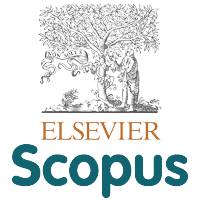Compatibility Test of Four Trichoderma spp. Isolates on Several Synthetic Pesticides
Abstract
Keywords
Full Text:
PDFReferences
Aktar, M. W., Sengupta, D., & Chowdhury, A. (2009). Impact of pesticides use in agriculture: Their benefits and hazards. Interdisciplinary Toxicology, 2(1), 1–12. crossref
Bagwan, N. B. (2010). Evaluation of Trichoderma compatibility with fungicides, pesticides, organic cakes and botanicals for integerated management of soil borne diseases of soybean [Glycine max (L.) Merril]. International Journal of Plant Protection, 3(2), 206–209. Retrieved from PDF
Bailey, B. A., Bae, H., Strem, M. D., Crozier, J., Thomas, S. E., Samuels, G. J., … Holmes, K. A. (2008). Antibiosis, mycoparasitism, and colonization success for endophytic Trichoderma isolates with biological control potential in Theobroma cacao. Biological Control, 46(1), 24–35. crossref
Barakat, F. M., Abada, K. A., Abou-Zeid, N. M., & El-Gammal, Y. H. E. (2014). Effect of volatile and non-volatile compounds of Trichoderma spp. on Botrytis fabae the causative agent of faba bean chocolate spot. American Journal of Life Sciences, 2(6–2), 11. crossref
Benhamou, N., & Chet, I. (1997). Cellular and molecular mechanisms involved in the interaction between Trichoderma harzianum and Pythium ultimum. Applied and Environmental Microbiology, 63(5), 2095–2099. Retrieved from website
Benítez, T., Rincón, A. M., Limón, M. C., & Codón, A. C. (2004). Biocontrol mechanisms of Trichoderma strains. International Microbiology, 7, 249–260. Retrieved from PDF
Bhatnagar, H. (1995). Integrated use of biocontrol agents with fungicides to control wilt incidence in pigeon-pea. World Journal of Microbiology & Biotechnology, 11(5), 564–566. crossref
Černohlávková, J., Jarkovský, J., & Hofman, J. (2009). Effects of fungicides mancozeb and dinocap on carbon and nitrogen mineralization in soils. Ecotoxicology and Environmental Safety, 72(1), 80–85. crossref
Chowdhury, A., Pradhan, S., Saha, M., & Sanyal, N. (2008). Impact of pesticides on soil microbiological parameters and possible bioremediation strategies. Indian Journal of Microbiology, 48(1), 114–127. crossref
Cooper, J., & Dobson, H. (2007). The benefits of pesticides to mankind and the environment. Crop Protection, 26(9), 1337–1348. crossref
Cycoń, M., Piotrowska-Seget, Z., & Kozdrój, J. (2010). Responses of indigenous microorganisms to a fungicidal mixture of mancozeb and dimethomorph added to sandy soils. International Biodeterioration and Biodegradation, 64(4), 316–323. crossref
Day, K. E., & Maguire, R. J. (1990). Acute toxicity of isomers of the pyrethroid insecticide deltamethrin and its major degradation products to Daphnia magna. Environmental Toxicology and Chemistry, 9, 1297–1300. crossref
Direktorat Pupuk dan Pestisida. (2016). Pestisida pertanian dan kehutanan tahun 2016 [Pesticides of agriculture and forestry 2016]. Jakarta: Ditjen PSP. Retrieved from PDF
Dwimartina, F., Arwiyanto, T., & Joko, T. (2017). Potential of endophytic and rhizobacteria as an effective biocontrol for Ralstonia syzygii subsp. syzygii. Asian Journal of Plant Pathology, 11, 191–198. crossref
El Khoury, W., & Makkouk, K. (2010). Integrated plant disease management in developing countries. Journal of Plant Pathology, 92(4, supplement), 35–42. Retrieved from website
Elad, Y., Barak, R., & Chet, I. (1984). Parasitism of sclerotia of Sclerotium rolfsii by Trichoderma harzianum. Soil Biology and Biochemistry, 16(4), 381–386. crossref
Erper, I., Turkkan, M., Atanasova, L., Druzhinina, I. S., Karaca, G. H., & Cebi-Kilicoglu, M. (2013). Integrated assessment of the mycoparasitic and phytostimulating properties of Trichoderma strains against Rhizoctonia solani. Bulgarian Journal of Agricultural Science, 19(4), 742–748. Retrieved from PDF
Gómez, I., Chet, I., & Herrera-Estrella, A. (1997). Genetic diversity and vegetative compatibility among Trichoderma harzianum isolates. Molecular and General Genetics, 256(2), 127–135. crossref
Gowdar, S. B., Babu, H. N. R., Nargund, V. B., & Krishnappa, M. (2006). Compatibility of fungicides with Trichoderma harzianum. Agricultural Science Digest, 26(4), 279–281. Retrieved from website
Haggag, W. M., & Abo-Sedera, S. A. (2005). Characteristics of three Trichoderma species in peanut haulms compost involved in biocontrol of cumin wilt disease. International Journal of Agriculture and Biology, 7(2), 222–229. Retrieved from PDF
Harman, G. E. (2006). Overview of mechanisms and uses of Trichoderma spp. Phytopathology, 96(2), 190–194. crossref
Haryono, J., Prihatiningsih, N., Wardhana, R. A., & Soesanto, L. (2009). Pengaruh pemasteuran tanah tunggal atau digabung agensia hayati terhadap pengelolaan penyakit busuk hati di pembibitan pisang [The effect of soil pasteurization alone or in combination with biological agents on heart rot disease management of banana seed]. Akta Agrosia, 12(1), 21–28. Retrieved from PDF
Henis, Y., Adams, P. B., Lewis, J. A., & Papavizas, G. C. (1983). Penetration of sclerotia of Sclerotium rolfsii by Trichoderma spp. Phytopathology, 73, 1043–1046. Retrieved from PDF
Howell, C. R. (2003). Mechanisms employed by Trichoderma species in the biological control of plant diseases: The history and evolution of current concepts. Plant Disease, 87(1), 4–10. crossref
Jegathambigai, V., Wilson Wijeratnam, R. S., & Wijesundera, R. L. C. (2010). Effect of Trichoderma sp. on Sclerotium rolfsii, the causative agent of collar rot on Zamioculcas zamiifolia and an on farm method to mass produce Trichoderma species. Plant Pathology Journal, 9, 47–55. crossref
Joko, T., Koentjoro, M. P., Somowiyarjo, S., Rohman, M. S., Liana, A., & Ogawa, N. (2012). Response of rhizobacterial communities in watermelon to infection with cucumber green mottle mosaic virus as revealed by cultivation-dependent RISA. Archives of Phytopathology and Plant Protection, 45(15), 1810–1818. crossref
Karthikeyan, A., Kumar, S., & Kumar, S. (2003). Trichoderma viride: A mycoparasite for the control of Phytophthora cinnamomi. Indian Forester, 129(5), 631–634. Retrieved from website
Khan, M. O., & Shahzad, S. (2007). Screening of Trichoderma species for tolerance to fungicides. Pakistan Journal of Botany, 39(3), 945–951. Retrieved from PDF
Köprücü, K., & Seker, E. (2008). Acute toxicity of deltamethrin for freshwater mussel, Unio elongatulus eucirrus bourguignat. Bulletin of Environmental Contamination and Toxicology, 80(1), 1–4. crossref
Lilly, V. G., & Barnett, H. L. (1951). Physiology of the fungi. New York, Toronto, London: McGraw-Hill Book Company, Inc. Retrieved from website
Lo, C.-C. (2010). Effect of pesticides on soil microbial community. Journal of Environmental Science and Health Part. B, 45(5), 348–359. crossref
Mahfut, Joko, T., & Daryono, B. S. (2016). Molecular characterization of odontoglossum ringspot virus (ORSV) in Java and Bali, Indonesia. Asian Journal of Plant Pathology, 10(1–2), 9–14. crossref
Monte, E. (2001). Understanding Trichoderma: between biotechnology and microbial ecology. International Microbiology, 4(1), 1–4. crossref
Oda, S. S., & El-Maddawy, Z. K. (2012). Protective effect of vitamin E and selenium combination on deltamethrin-induced reproductive toxicity in male rats. Experimental and Toxicologic Pathology, 64(7–8), 813–819. crossref
Paret, M., Dufault, N., Momol, T., Marois, J., & Olson, S. (2015). Integrated disease management for vegetable crops in Florida. Florida: University of Florida. Retrieved from PDF
Probowo, A., Prihatiningsih, N., & Soesanto, L. (2006). Potensi Trichoderma harzianum dalam mengendalikan sembilan isolat Fusarium oxysporum Schlecht. f. sp. zingiberi Trujillo pada kencur [Potency of Trichoderma harzianum in controlling nine isolates of Fusarium oxysporum Schlecht. f. sp. zingiberi Trujilo on galanga]. Jurnal Ilmu-Ilmu Pertanian Indonesia, 8(2), 76–84. Retrieved from PDF
Reithner, B., Ibarra-Laclette, E., Mach, R. L., & Herrera-Estrella, A. (2011). Identification of mycoparasitism-related genes in Trichoderma atroviride. Applied and Environmental Microbiology, 77(13), 4361–4370. crossref
Santoso, S. E., Soesanto, L., & Haryanto, T. A. D. (2007). Penekanan hayati penyakit moler pada bawang merah dengan Trichoderma harzianum, Trichoderma koningii, dan Pseudomonas fluorescens P60 [Biological suppression of moler disease on shallot by Trichoderma harzianum, Trichoderma koningii, and Pseudomonas fluorescens P60]. Jurnal Hama Dan Penyakit Tumbuhan Tropika, 7(1), 53–61. Retrieved from website
Sengupta, D., Aktar, M. W., Alam, S., & Chowdhury, A. (2010). Impact assessment and decontamination of pesticides from meat under different culinary processes. Environmental Monitoring and Assessment, 169(1–4), 37–43. crossref
Sharma, B. K., Singh, B. M., & Sugha, S. K. (1992). Integrated effect of biological and chemical control on sclerotial viability of Sclerotinia sclerotiorum (Lib.) de Bary. Journal of Biological Control, 6(1), 29–34. Retrieved from website
Singh, V. P., Srivastava, S., Shrivastava, S. K., & Singh, H. B. (2012). Compatibility of different insecticides with Trichoderma harzianum under in vitro condition. Plant Pathology Journal, 11(2), 73–76. crossref
Soesanto, L., Sudarmono, Prihatiningsih, N., Manan, A., Iriani, E., & Pramono, J. (2005). Potensi agensia hayati dan nabati dalam mengendalikan penyakit busuk rimpang jahe [Potency of biological and botanical agents in controlling ginger rhizome rot]. Jurnal Hama Dan Penyakit Tumbuhan Tropika, 5(1), 50–57. Retrieved from website
Soytong, K., & Quyet, N. T. (2013). Production of organic compost from mushroom producing substances waste and tested for Kangkong organic cultivation. International Journal of Agricultural Technology, 9(1), 115–123. Retrieved from website
Sutton, L. M., & Starzyk, M. J. (1972). Procedure and analysis of a useful method in determining mycelial dry weights from agar plates. Applied Microbiology, 24(6), 1011–1012. Retrieved from website
Thakore, Y. (2006). The biopesticide market for global agricultural use. Industrial Biotechnology, 2(3), 194–208. crossref
Vinale, F., Sivasithamparam, K., Ghisalberti, E. L., Marra, R., Woo, S. L., & Lorito, M. (2008). Trichoderma-plant-pathogen interactions. Soil Biology and Biochemistry, 40(1), 1–10. crossref
Wardhana, D. W., Soesanto, L., & Utami, D. S. (2009). Penekanan hayati penyakit layu Fusarium pada subang gladiol [Biological suppression of Fusarial Wilt on gladiolus corms]. Jurnal Hortikultura, 19(2), 199–206. Retrieved from website
Yang, C., Hamel, C., Vujanovic, V., & Gan, Y. (2011). Fungicide: Modes of action and possible impact on nontarget microorganisms. ISRN Ecology, 2011, 1–8. crossref
Yildirim, M. Z., Benli, A. Ç. K., Selvi, M., Özkul, A., Erkoç, F., & Koçak, O. (2006). Acute toxicity, behavioral changes, and histopathological effects of deltamethrin on tissues (gills, liver, brain, spleen, kidney, muscle, skin) of Nile tilapia (Oreochromis niloticus L.) fingerlings. Environmental Toxicology, 21(6), 614–620. crossref
Zimand, G., Elad, Y., & Chet, I. (1996). Effect of Trichoderma harzianum on Botrytis cinerea pathogenicity. Phytopathology, 86, 1255–1260. crossref
DOI: http://doi.org/10.17503/agrivita.v40i3.1126
Copyright (c) 2018 UNIVERSITAS BRAWIJAYA

This work is licensed under a Creative Commons Attribution-NonCommercial 4.0 International License.








